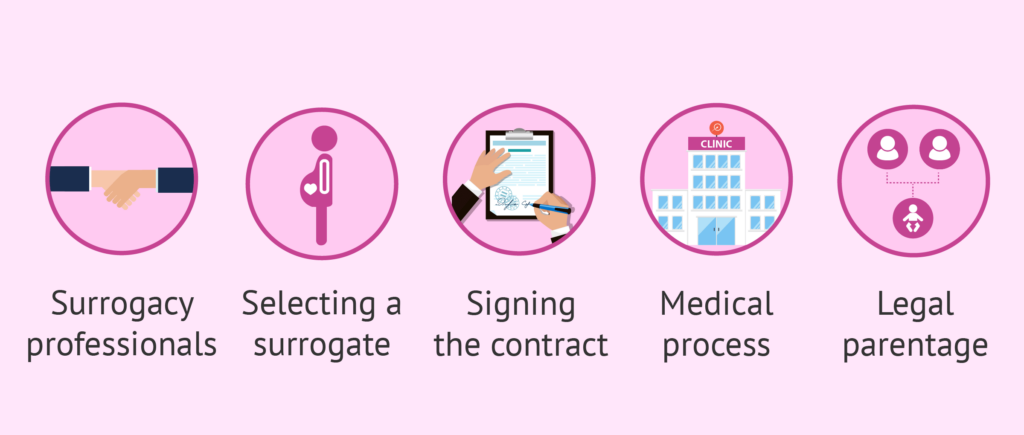Kardashian Surrogate
Kim Kardashian’s reason for surrogacy
Kim Kardashian and her sister, Khloe Kardashian, have both opted to use surrogacy to welcome children after they previously had children through natural births. In addition to Khloe Kardashian and Tristan’s son, Kim Kardashian’s two youngest children, Chicago and Psalm, were both born through surrogacy. Kim has been very open about the use of surrogacy to welcome children with her no ex-husband, Kanye West. The reason she said she gave for using a surrogate was that she suffered from placenta accrete during her first two pregnancies. This is a condition where the placenta grows into the uterine wall during pregnancy.

Normally after childbirth, the placenta separates from the uterine wall, but with the placenta accrete, it remains attached. The condition often occurs without any symptoms and cannot be prevented. Kim said that the condition is what usually leads to the death of women during childbirth. The placenta had to be gotten out within a period, or there could be internal bleeding. After the cutting off of the placenta, she said it left a hole in her uterus, and that the muscle didn’t grow back. However, in addition to the placenta accrete, she also had preeclampsia during her first pregnancy. This is also called toxaemia, and it leads to the shutdown of organs, which is why her labour was induced after only 34 weeks. When she also suffered the same condition during her second pregnancy, she and her former partner then decided to have their subsequent children via surrogacy.
Khloe Kardashian’s reason for using a surrogate
Khloe Kardashian, on the other hand, while not being open about the reason she chose surrogacy, was quite expressive of the emotional turmoil that came along with the process. She shared her opinion on how surreal the whole experience was, and how she did not properly digest what was going on. Khloe remarks on how when she went to the hospital was the first time it registered that she was having a baby, and how she was in a state of shock from the entire experience. She went on to say that the process felt very transactional.

Surrogacy and egg donation are becoming more common than ever, especially with the fact that celebrities are leading the way as some of the most vocal supporters of the process. This highlights the challenges that they go through. After all, these celebrities are human with human problems and the same biological constraints that are the reality for several women. Just like every other individual who wants to get pregnant or have children on their own that, due to one issue or another, cannot, these celebrities turn to surrogacy or egg donation to start their families.
What is Surrogacy?
Surrogacy is a form of assisted reproductive technology where a woman, who is referred to as the surrogate, offers to carry a pregnancy for another person or a couple that is known as the intended parent or parents. After the delivery, the surrogate then hands the baby over to the intended parents. Surrogacy is a complicated process that usually has a lot of steps that need to be taken to ensure that both parties make the best decision. This will include extensive counselling, psychological assessment, mental profiling and independent legal advice.
Surrogacy has different regulations in different countries. In some countries, it has legal guidelines that must be followed. These countries will usually have conditions that must be met by the intended parents to make it legal. Countries like Russia or Georgia have strict regulations for individuals who seek surrogacy in their country. In some countries, surrogacy is outlawed completely; an example is in India where the parliament. In other countries, there are no specific regulations around surrogacy; examples are Cyprus, Nigeria and Kenya. This is why depending on the particular country that the intended parents reside in, they will need to go to another country to access surrogacy. This can usually be achieved with the help of medical health travel agencies or meditour agencies, who offer surrogacy as a form of overseas medical treatment. This is usually considered a form of health tourism or medical tourism in these countries.
What are the types of surrogacy?
There are two types of surrogacy that are widely recognized, these include:
Traditional or altruistic surrogacy
This is the type of surrogacy where the surrogate gets pregnant using her eggs. The sperm will be from the intended parents or a donor. This type of surrogacy creates a genetic relationship between the surrogate and the baby. This genetic relationship in some cases leads to issues in the case, especially when after the delivery, the surrogate changes her mind about handing the baby over to the intended parents. This is the reason why this type of surrogacy is not popular with fertility or surrogacy clinics. However, in some countries like Australia, this is the only type of surrogacy that is legal.
Gestational surrogacy or commercial surrogacy
This is the type of surrogacy where the eggs and the sperm that are used to create the embryo are donated by the intended parents or through donors. After the creation of the embryo, the lab grows the embryo for a few days; then it is transferred to the uterus of the surrogate. This type of surrogacy ensures that there is no genetic relationship between the baby and the surrogate. This goes a long way in ensuring that there are no future complications even in the instance that the surrogate mother changes her mind about giving up the baby to the intended parents. This type of surrogacy is popular with fertility agencies; it is also legal in some countries like Georgia, but only for their citizens.
What are the steps that are involved in the surrogacy process?

It is important to know the steps that will be followed to properly carry out a successful surrogacy process; they include:
- The initial consultation with the surrogacy agency
- Sourcing the egg and the sperm that will be used in the surrogacy process
- Choosing the surrogate
- The fertilization and the embryo transfer process
- Maternity and childbirth
- Transfer of legal parenthood
The information provided in this blog is for educational purposes only and should not be considered as medical advice. It is not intended to replace professional medical consultation, diagnosis, or treatment. Always consult with a qualified healthcare provider before making any decisions regarding your health. Read more







